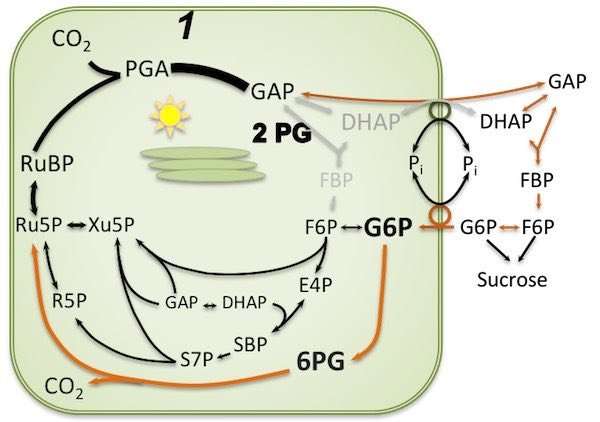Keeping plants nourished—the workings of a photosynthesis backup system

Photosynthesis is how plants 'make their food' and feed the rest of the planet. The key ingredient in that recipe is carbon. So, the process captures energy from the sun, which is then used to tear away carbon from atmospheric CO2.
But the journey from sunlight to feeding the planet is not a straight line. It's more of a series of routes and detours that lead to the finish line. The reason is that things can go wrong. Light quality changes, or it gets too dry, or too cold. These changes can slow down or damage photosynthesis. So, plants have backups to work around these situations.
Scientists want to know these ins and outs of in order to improve expand iconphotosynthesis. The big picture goal is to create plants with better yields in order to feed our rapidly growing population.
Now, researchers at the MSU-DOE Plant Research Laboratory (PRL) shed more light on one of the backups that support photosynthesis through difficult conditions. The study is published in bioRxhiv.
Carbon: the plant's money-maker
Plants introduce carbon into their diet through a photosynthetic process known as the expand iconjavascript:void(0)Calvin-Benson cycle. This series of reactions mixes carbon with other chemicals to make new compounds, like starch or sugars, that sustain the plants and the rest of the food chain.
Carbon is truly key to having life on Earth.
However, two out of five times, the cycle picks up oxygen instead of carbon dioxide. That hiccup, called expand iconoxygenation, creates compounds that plants can't use to grow. Even worse, it grinds the cycle to a halt.
Plants have to clean those compounds and re-introduce them into the cycle so it can restart. The effort costs time and energy and requires moving the compounds to special cleaning sites elsewhere in the cell.
"The Calvin-Benson cycle has built-in backups to quickly restart the process whenever it slows down," says Tom Sharkey, University Distinguished Professor at the PRL. "The best way is a shunt, a series of side reactions that keeps a low flow of carbon products in the cycle. That makes sure the cycle restarts as fast as possible."
Now, the Sharkey lab, using plants that can't clean up compounds made by oxygenation, sheds more light on how the shunt works and how it needs extra photosynthetic energy to function.

The shunt: keeping the money-maker safe
An analogy for the shunt is the pilot light found in older gas appliances. This small flow of gas keeps the flame lit at a minimal level, so that when gas is supplied, the furnace, hot water heater, or stove very quickly turns on.
"The pilot light could seem to be a waste of gas," Tom says. "But it serves an important function by keeping the system ready to come on fully very rapidly, without the user having to find a match to light the flame."
Tom and two other labs at the PRL, Kramer and Hu, screened for mutant plants with defects in cleaning compounds mixed with oxygen. One mutant had a flaw at one of the special cleaning sites, the peroxisome.
The mutation slowed down the cleaning process, which led the plant to accumulate bad compounds at much higher levels compared to healthy plants.
That accumulation stopped the Calvin-Benson cycle. Since the mutant plant couldn't properly restart the cycle, it found a workaround:
- The plant moved carbon outside the cycle and into the plant cell;
- It partially processed the carbon in a way similar to what goes on in the cycle;
- It reinserted the carbon into the cycle through a backdoor that opened up for this situation.
- The shunt grabbed and then pumped some of that carbon back into the cycle to help reboot it.
"The shunt's increased activity requires extra energy," Tom says. "Photosynthesis compensates by cranking up production (of ATP) in order to feed the shunt and drive the Calvin-Benson cycle."
How the shunt works in real-world conditions
Even though the mutant is an exception, it forced the plant to reveal workarounds that are hard to see in healthy plants.
"In healthy plants, the Calvin-Benson cycle only works when there is light," Tom says. "But in nature, there can be wide changes, like moving clouds, that make light flicker on and off. In those situations, it is easy to collapse the Calvin-Benson cycle. We think the shunt plays a role in restarting it."
"Nowadays, electronics have made the pilot light obsolete," Tom adds.
"Similarly, once we fully understand the shunt, maybe we will be able to replace it with a more efficient system."
Tom concludes, "We're lucky at the PRL. This project wouldn't have happened if the other PRL labs hadn't asked me questions about the Calvin-Benson cycle. It is unusual to have so many people, specializing in different parts of photosynthesis, working together under one roof. We can get out of our comfort zones, talk, and collaborate on research projects that otherwise don't come up."
More information: Loss of Peroxisomal Hydroxypyruvate Reductase Inhibits Triose Phosphate Isomerase but Stimulates Cyclic Photosynthetic Electron Flow and the Glc-6P-Phosphate Shunt, www.biorxiv.org/content/early/2018/03/08/278580
Provided by Michigan State University


















